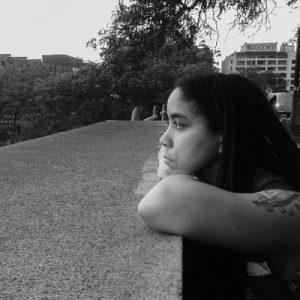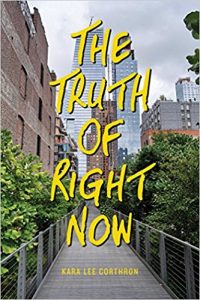On Genre Hopping
 In a recent fellowship application, I described myself as a “multidisciplinary” writer. (I feel like could devise a better term, but until then, this one is as good as any.) Here’s a rough synopsis of what I do: I’ve been writing plays for fifteen years now, currently I have a musical in the works; I write Young-Adult novels—my debut, The Truth of Right Now, just came out in paperback; I am collaborating with cartoonist Shawn Ferreyra on a graphic novel; and occasionally I write for television. Regardless of the genre, my process doesn’t change much. Story is story. There are different rules for each discipline, some more stringent than others, but the way I approach storytelling remains consistent.
In a recent fellowship application, I described myself as a “multidisciplinary” writer. (I feel like could devise a better term, but until then, this one is as good as any.) Here’s a rough synopsis of what I do: I’ve been writing plays for fifteen years now, currently I have a musical in the works; I write Young-Adult novels—my debut, The Truth of Right Now, just came out in paperback; I am collaborating with cartoonist Shawn Ferreyra on a graphic novel; and occasionally I write for television. Regardless of the genre, my process doesn’t change much. Story is story. There are different rules for each discipline, some more stringent than others, but the way I approach storytelling remains consistent.
I’m not a huge fan of doling out advice. Especially “shoulds.” I hate “shoulds.” When I hear writing teachers telling their students all the things they should do (even if I agree), I feel like I’m breaking out in hives. Everybody is different. Every artistic journey is different. Every career path is different. So I won’t give some prescriptive method to branching out into different writing spheres. I’ll only share some pieces from my experience; some of what’s worked and some of what hasn’t.
Time is precious. No matter what, there’s never enough time and there never will be enough. So I use it to the best of my ability and make peace with the lost days—and there are many. Know that the problem of time has always been an issue for art makers. When I get frustrated, I remind myself of this Leonard Bernstein quote: “To achieve great things, two things are needed; a plan, and not quite enough time.”
Be open to unexpected opportunities. I can’t remember the first time someone asked me to try something I’d never thought about doing before. It actually might’ve been to teach, which is something I do quite a lot of now and it’s a major supplement to my income. Of course, no one has to be invited to explore new territory. I’ve written short stories because a contest or theme appeals to me. I haven’t had any success with that yet, but I learn from every new attempt regardless of the result. In general, when an opportunity presents itself, I ask myself “Why not?” and if I struggle to find answers to that question, it’s a risk worth taking.
Red Flags are real. A lesson I’ve had to learn more than once is to pay attention to red flags. I’m not talking about disagreements with a collaborator—director, editor, producer, etc. Those can be productive. On the other hand: Ever work with someone who casually uses abusive language to make a point? Thrives on conflict for no reason? Sneaks in condescending remarks whenever possible? I’m sorry to say that I have and I’ve ignored such behavior, wondering if my misgivings were all in my head. They weren’t. And those early warning signs led to far more disturbing events. It’s easy to repeat mistakes, so now if I ever feel especially uncomfortable, scared for my safety (yes, that has happened), or unreasonably stressed about a project, I take a serious pause. I assess and decide if I need to make a radical change. It’s the last resort, but leaving a project is sometimes the best option for your sanity and for the preservation of the work itself.
Say yes for the right reasons. Every now and then, an offer comes about and I don’t have to think twice: I know the answer is “yes.” A few examples: a book contract, a production, a sizable commission, etc. That’s the best-case scenario. More often I have to weigh the good with the bad, as sometimes saying “yes” to one project will mean saying “no” to something else. But I have finally wised up enough to know that this thought is a bad sign: “Well, I’ve got nothing else going on so I might as well just do it.” In my experience, that has been the WORST reason to do anything related to my career or my art. I am pretty busy these days, but that’s after suffering an abundance of dry years when I felt like my work was just going into a giant void. (And I’ll probably have years like that again.)
These are the moments when it’s extremely tempting to jump into something half-baked and/or ill-conceived just to be working. Looking back on the times when I did this, I know now I would’ve been much happier if I’d declined and continued writing for the void. Saying “yes” because you have nothing better to do is a great way to waste copious amounts of time (days, months, years), shed lots of tears, lie to yourself and others, and possibly destroy some relationships. No matter what I’m doing, a project has to excite me even when I find it frustrating. Otherwise, why the hell do it?
Seek Joy. Despite the challenges, writing across genres can be fun! It’s like having several personalities in your head but none of them want to harm you! They just want to shape your endless supply of creativity and put it to good use. Also, I can’t think of a better reaction to a playwriting rejection letter than “I don’t have time for this. The next draft of my book is due in two months!” Multidisciplinary writing (or whatever word I eventually invent) provides an agency in my life that anchors me when I feel at sea. I can’t allow myself to get dragged down by the countless losses and rejections. There isn’t time: a deadline is always looming.
—
Bio: Kara Lee Corthron has written many plays that have been performed around the U.S. Her debut YA novel, The Truth of Right Now, received the Parents’ Choice Gold Award and her second book is slated for the summer of 2019 (both from Simon Pulse/Simon & Schuster). To learn more, visit www.karaleecorthron.com.
THE TRUTH OF RIGHT NOW
 Two isolated teens struggle against their complicated lives to find a true connection in this “timely and timeless” (Kirkus Reviews, starred review) debut novel about first love and the wreckage of growing up.
Two isolated teens struggle against their complicated lives to find a true connection in this “timely and timeless” (Kirkus Reviews, starred review) debut novel about first love and the wreckage of growing up.
Lily is returning to her privileged Manhattan high school after a harrowing end to her sophomore year and it’s not pretty. She hates chemistry and her spiteful lab partner, her friends are either not speaking to her or suffocating her with concerned glances, and nothing seems to give her joy anymore. Worst of all, she can’t escape her own thoughts about what drove her away from everyone in the first place.
Enter Dari (short for Dariomauritius), the artistic and mysterious transfer student, adept at cutting class. Not that he’d rather be at home with his domineering Trinidadian father. Dari is everything that Lily needs: bright, creative, honest, and unpredictable. And in a school where no one really stands out, Dari finds Lily’s sensitivity and openness magnetic. Their attraction ignites immediately, and for the first time in what feels like forever, Lily and Dari find happiness in each other.
In twenty-first-century New York City, the fact that Lily is white and Dari is black shouldn’t matter that much, but nothing’s as simple as it seems. When tragedy becomes reality, can friendship survive even if romance cannot?
Category: How To and Tips

























